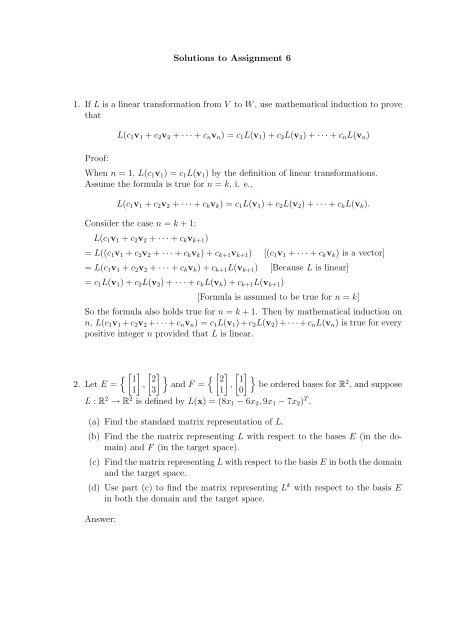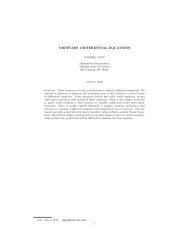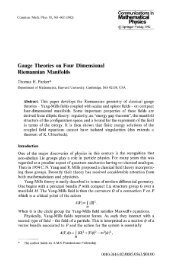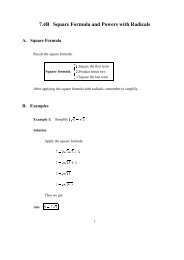Solutions to Assignment 6 1. If L is a linear transformation from V to ...
Solutions to Assignment 6 1. If L is a linear transformation from V to ...
Solutions to Assignment 6 1. If L is a linear transformation from V to ...
You also want an ePaper? Increase the reach of your titles
YUMPU automatically turns print PDFs into web optimized ePapers that Google loves.
<strong>Solutions</strong> <strong>to</strong> <strong>Assignment</strong> 6<br />
<strong>1.</strong> <strong>If</strong> L <strong>is</strong> a <strong>linear</strong> <strong>transformation</strong> <strong>from</strong> V <strong>to</strong> W , use mathematical induction <strong>to</strong> prove<br />
that<br />
Proof:<br />
L(c1v1 + c2v2 + · · · + cnvn) = c1L(v1) + c2L(v2) + · · · + cnL(vn)<br />
When n = 1, L(c1v1) = c1L(v1) by the definition of <strong>linear</strong> <strong>transformation</strong>s.<br />
Assume the formula <strong>is</strong> true for n = k, i. e.,<br />
L(c1v1 + c2v2 + · · · + ckvk) = c1L(v1) + c2L(v2) + · · · + ckL(vk).<br />
Consider the case n = k + 1:<br />
L(c1v1 + c2v2 + · · · + ckvk+1)<br />
= L((c1v1 + c2v2 + · · · + ckvk) + ck+1vk+1) [(c1v1 + · · · + ckvk) <strong>is</strong> a vec<strong>to</strong>r]<br />
= L(c1v1 + c2v2 + · · · + ckvk) + ck+1L(vk+1) [Because L <strong>is</strong> <strong>linear</strong>]<br />
= c1L(v1) + c2L(v2) + · · · + ckL(vk) + ck+1L(vk+1)<br />
[Formula <strong>is</strong> assumed <strong>to</strong> be true for n = k]<br />
So the formula also holds true for n = k + <strong>1.</strong> Then by mathematical induction on<br />
n, L(c1v1 + c2v2 + · · · + cnvn) = c1L(v1) + c2L(v2) + · · · + cnL(vn) <strong>is</strong> true for every<br />
positive integer n provided that L <strong>is</strong> <strong>linear</strong>.<br />
<br />
2. Let E =<br />
<br />
1 2<br />
<br />
, and F =<br />
1 3<br />
<br />
2 1<br />
<br />
, be ordered bases for R<br />
1 0<br />
2 , and suppose<br />
L : R2 → R2 <strong>is</strong> defined by L(x) = (8x1 − 6x2, 9x1 − 7x2) T .<br />
(a) Find the standard matrix representation of L.<br />
(b) Find the the matrix representing L with respect <strong>to</strong> the bases E (in the domain)<br />
and F (in the target space).<br />
(c) Find the matrix representing L with respect <strong>to</strong> the bas<strong>is</strong> E in both the domain<br />
and the target space.<br />
(d) Use part (c) <strong>to</strong> find the matrix representing L k with respect <strong>to</strong> the bas<strong>is</strong> E<br />
in both the domain and the target space.<br />
Answer:
(a) The standard matrix representation <strong>is</strong><br />
<br />
A = L<br />
<br />
1<br />
<br />
, L<br />
0<br />
<br />
0<br />
<br />
=<br />
1<br />
(b) The matrix for L relative <strong>to</strong> bases E, F <strong>is</strong><br />
B = F −1<br />
<br />
L<br />
<br />
1<br />
<br />
, L<br />
1<br />
<br />
2<br />
<br />
3<br />
= 1<br />
−1<br />
(c) The matrix for L relative <strong>to</strong> bas<strong>is</strong> E <strong>is</strong><br />
C = E −1<br />
<br />
L<br />
<br />
1<br />
<br />
, L<br />
1<br />
<br />
2<br />
<br />
3<br />
Alternatively,<br />
C = E −1 AE =<br />
= 1<br />
1<br />
0 −1<br />
−1 2<br />
3 −2<br />
−1 1<br />
<br />
8 −6<br />
9 −7<br />
<br />
3<br />
<br />
−2 8<br />
<br />
−6 1<br />
<br />
2<br />
−1 1 9 −7 1 3<br />
(d) The matrix for L k relative <strong>to</strong> bas<strong>is</strong> E <strong>is</strong> C k =<br />
2 −2<br />
2 −3<br />
2 −2<br />
2 −3<br />
=<br />
<br />
=<br />
<br />
=<br />
<br />
2 0<br />
0 −1<br />
<br />
2<br />
<br />
−3<br />
−2 4<br />
<br />
2 0<br />
0 −1<br />
k <br />
k 2 0 2 0<br />
=<br />
0 −1 0 (−1) k<br />
<br />
.<br />
3. Let A and B be similar matrices and let λ be any scalar. Show that:<br />
(a) det(A) = det(B).<br />
(b) A − λI and B − λI are similar.<br />
Answer:<br />
(a) A = S −1 BS for some nonsingular matrix S. Then<br />
det(A) = det(S −1 BS) = det(S −1 ) det(B) det(S) =<br />
(b) Note that λI = S −1 (λI)S for any scalar λ. Then<br />
A − λI = S −1 BS − S −1 (λI)S = S −1 (B − λI)S.<br />
1<br />
det(B) det(S) = det(B).<br />
det(S)<br />
So by definition of similar matrices, A − λI and B − λI are similar for any<br />
scalar λ.<br />
2












